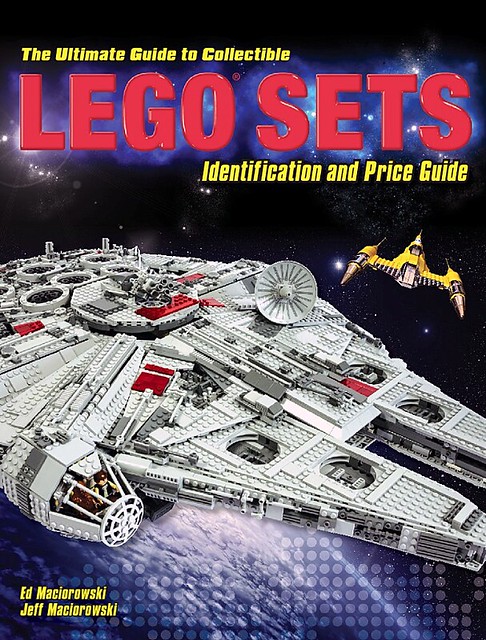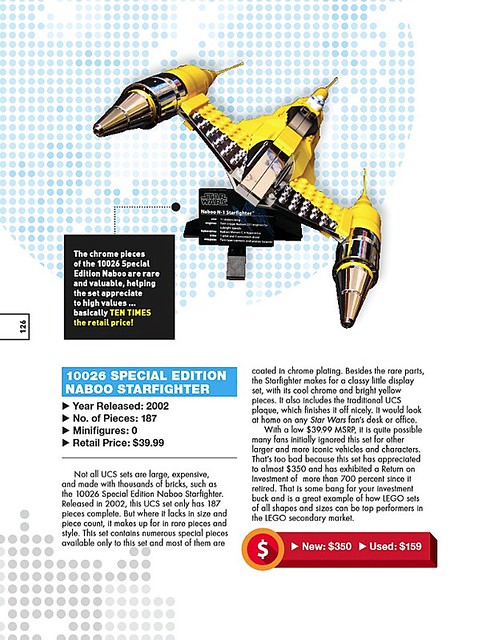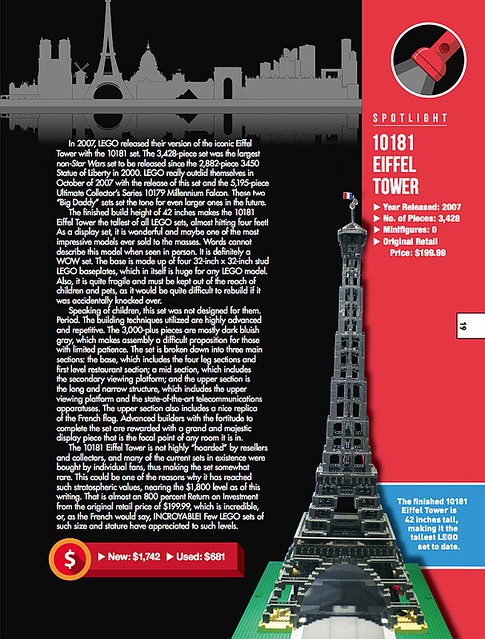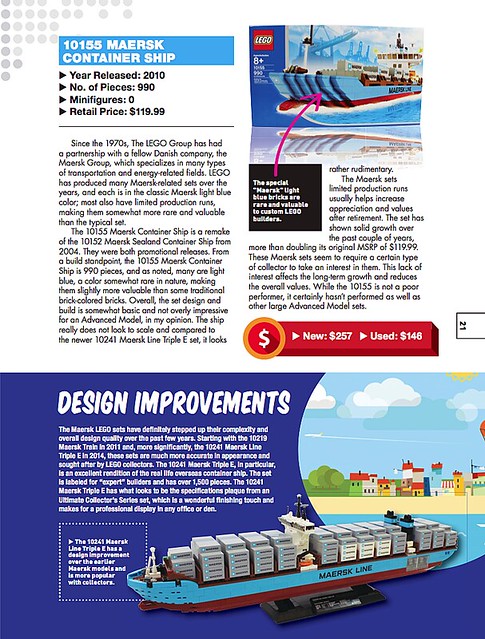| Set 10179 UCS Millennium Falcon (2007). RRP $499.99. Price now $3,450 (new), $2,064 (used) |
At the risk of stating the obvious, reselling in this context is basically the act of buying up currently available sets and then selling them on for a profit at a later date. Reselling typically occurs after LEGO have stopped making a particular set and supply of that set has dried up, although it's also seen in the short term ('flipping') at times of product shortage when a popular item is temporarily sold out, for instance around Christmas or other holidays.
Set 10182 Cafe Corner (2007). Retail price $139.99. Price now $1,671 (new), $736 (used) |
So why is reselling such a divisive issue within the LEGO fan community? Well, critics of reselling highlight multiple concerns. For starters, some LEGO fans clearly feel deep discomfort at what they see as the commoditization of the LEGO hobby by individuals who they perceive as not having any interest in the brand itself and who are only in it for the money. There's also resentment at being "held to ransom" by speculators when trying to buy retired sets, and accusations that resellers are often guilty of greedily emptying the shelves of discounted sets, thus denying other LEGO fans access to bargains. Furthermore, resellers are accused of themselves precipitating shortages of in-demand items by buying up large quantities of stock, sometimes circumventing retailer limits in the process, only to then 'flip' the items at a profit and thus take advantage of the shortage that they themselves have created.
Set 10196 Grand Carousel (2009). RRP $249.99. Price now $2,278 (new), $1,215 (used) |
The flipside of the coin is that resellers provide a valuable source of product long after retailers and LEGO themselves have stopped selling particular sets. It's inconceivable, for instance, that I would have been able to aquire all the Star Wars sets that I missed prior to emerging from my Dark Ages without the help of numerous resellers operating via eBay and Bricklink. Also, the accusation that resellers are all 'outsiders' milking the brand for profit is often wide of the mark, with many LEGO fans happy to indulge in a spot of reselling to help fund their expensive hobby. Then there are all those individuals who specialise in reselling LEGO elements, investing their time and effort into breaking down sets into their constituent parts and selling them via Bricklink; without this army of resellers, most of the magnificent MOCs that we admire online and at shows would never see the light of day.
Set 3450 Statue of Liberty (2000). RRP $198.99. Price now $2,181 (new), $1,054 (used) |
The upshot of all this is that the reseller debate gets played out regularly and repeatedly across LEGO forums, and the discussion is remarkably polarized and not infrequently descends into downright hostility as a result of the strength of feeling on both sides. Regardless of which side of the debate you come down on, however, it's evident that reselling is here to stay, at least until such time as the bottom falls out of the market, and there's no indication that we're in any danger of that happening any time soon.
Set 8169 Lamborghini Gallardo LP 560-4 (2009). RRP $59.99. Price now $253 (new), $93 (used) |
As LEGO has become increasingly popular, one interesting development has been the rise of the so-called 'LEGO investor', who treats LEGO sets as an investment for the future, akin to stocks and shares, or gold. This trend has undoubtedly been fuelled by the increasing attention afforded to the LEGO brand by the media, not to mention a succession of articles such as this one highlighting how certain LEGO sets have increased in value over time. It's against this backdrop that the BrickPicker website was founded back in 2011 by long-time LEGO fans Jeff and Ed Maciorowski. Having become aware of the rise in LEGO resale values, Jeff and Ed noticed that there was really no dedicated resource to help people figure out just how much their LEGO sets had appreciated in value over the years and so they set about building their own site to do just that, using actual sales data from the likes of eBay to compile the numbers. As interest in LEGO investing has grown, so the BrickPicker site has become increasingly popular, and it's since added a discussion forum and a classifieds section to the price guides which form the core of the site.
Set 10020 Santa Fe Super Chief (2002). RRP $39.99. Price now $265 (new), $203 (used) |
I've met Jeff a few times during his occasional business trips to London, and in February of this year he approached me to let me know that he and Ed were working on a LEGO collecting and price guide. He asked if they could use a few of my photographs in the book, and I was happy to grant them permission. Fast forward nine months and a courtesy copy of their book, The Ultimate Guide to Collectible LEGO Sets: Identification and Price Guide, dropped through my letterbox. You can see a cover shot and a selection of sample spreads below.
I have to admit that I didn't really know what to expect from the book; on the basis of the title I had visions of a stuffy encyclopaedia full of page upon page of set numbers, part counts, prices and Compound Annual Growth Rates. Thankfully that's not what I found when I dived in, however; while dense listings of prices and CAGR data do make an appearance at the end of the book, they comprise a relatively small proportion of the overall content.
The book is a paperback and has a footprint which isn't far short of A4 size. It feels well put-together overall, with sturdy binding and thick, glossy pages, and it's pretty substantial, weighing in at almost 900 grams and containing more than 250 pages. In terms of organisation, the book is divided into 28 chapters which cover the key LEGO themes since 2000. Star Wars gets two chapters, one for UCS sets and one for everything else, and there's also an 'Advanced Models' chapter featuring Modular Buildings and LEGO Exclusives, a chapter focusing on trains, a chapter covering sets released prior to 2000, and a chapter for themes not covered elsewhere plus promo items.
I'm pleased to report that it's a pretty good read. Within each chapter standout sets are discussed in an easy-going, conversational and at times humorous style, and while pricing data are included they don't dominate proceedings. Even though the book is more than 250 pages in length, LEGO's rich back-catalogue of releases means that it's plainly impossible to highlight every set, and as a consequence the authors have had to make a judgement call on which sets to focus on so some fans will inevitably be disappointed that one or more of their favourites aren't discussed in more detail. That having been said, since the choice of sets highlighted in the book is at least in part driven by resale value rather than just a subjective opinion of a set's merits, it could be argued that the set selection is less arbitrary and subjective than that seen in other books, for instance Dorling Kindersley's (admittedly excellent) recent Great LEGO Sets release.
If I have a content-related criticism it's that very little space is allocated to sets released before 2000 - the pre-2000 chapter consists of just 5 pages and only covers seven sets. The justification given for this is that sets released post-1999 are on a different level in terms of creativity and complexity; while that may be true, the book is ostensibly a price guide and the perceived complexity of a set therefore doesn't seem like a particularly logical reason to include, or exclude, it. That having been said, per my comments above regarding the difficulty of deciding which sets to include and which to omit, the authors clearly had to draw the line somewhere, and on the upside the cut-off means that the selection of post-1999 sets included in the book is more comprehensive and complete than it would otherwise have been.
Overall, the book is an unexpectedly easy read, and I think that it'd be of potential interest to LEGO fans in general and not just to LEGO investors and occasional resellers. Less than 20% of the 250+ pages are taken up by tables of pricing data, and I think that's a good thing; it's not so much that such information isn't interesting or useful, more that the data will presumably be out of date fairly quickly, plus up-to-date pricing data are available for free on the BrickPicker site anyway, so there seems little incentive to buy the book for the pricing data alone. Pleasingly, the majority of content consists of well-researched commentary on a large and diverse selection of LEGO sets written by a couple of knowledgeable AFOLs, so there's actually much to enjoy for the average LEGO fan, reseller or not - definitely worth a read.







No comments:
Post a Comment